Nathaniel Williams was born in Alabama, studied Painting and Puppetry in Switzerland and Political Theory in Albany, and established an Art School in Upstate New York with a view of the Catskill Mountains. Now, the long legged man has arrived in the Jura Hills as a new member of the Goetheanum Leadership. His aim is to connect the world movement with the school for spiritual science and provide young people with a supportive environment for a practical spiritual training. Questions by Philipp Tok.
Arriving
Philipp You made the decision to join the Goetheanum almost a year ago. That’s a lot of time to build up images of what it would be like. How does it feel now that you have arrived?
Nathaniel What I was doing in New York was so all-consuming, that it was really difficult for me to imagine anything about coming here. During the year, I also became a father for the second time, and even in the last month, I created an artistic performance, building and using analog light projection instruments with a friend composing music for it. We performed three times in Hudson, New York.
At the same time, this sheds a light on my decision to say yes to come to Dornach. I can’t say I had a flood of pictures of what the job would be like or what the tasks would be – it was something more mysterious. It was like a resolution in my will. I had never experienced anything like it, but I think I recognize it in a certain connection with my experience of the spiritual movement of Anthroposophy and wanting to be part of serving it. There is a joy connected to it, as well as a clarity. Since I’ve arrived, I’ve been meeting young people and listening to them, and in the last three weeks, I’ve started to feel a flood of ideas and impulses coming out of meetings with people.
Philipp It was a clear yes, whether you liked it or not?
Nathaniel Exactly. It wasn’t so much like, ‹How do you feel about living in Switzerland?› Switzerland is beautiful and culturally and politically interesting, but my legs are long and I always feel a little bit hemmed in when I swing them around walking here. It wasn’t so much being enticed to live here, but it was more of a yes, the resolve to come here that I just had to recognize.

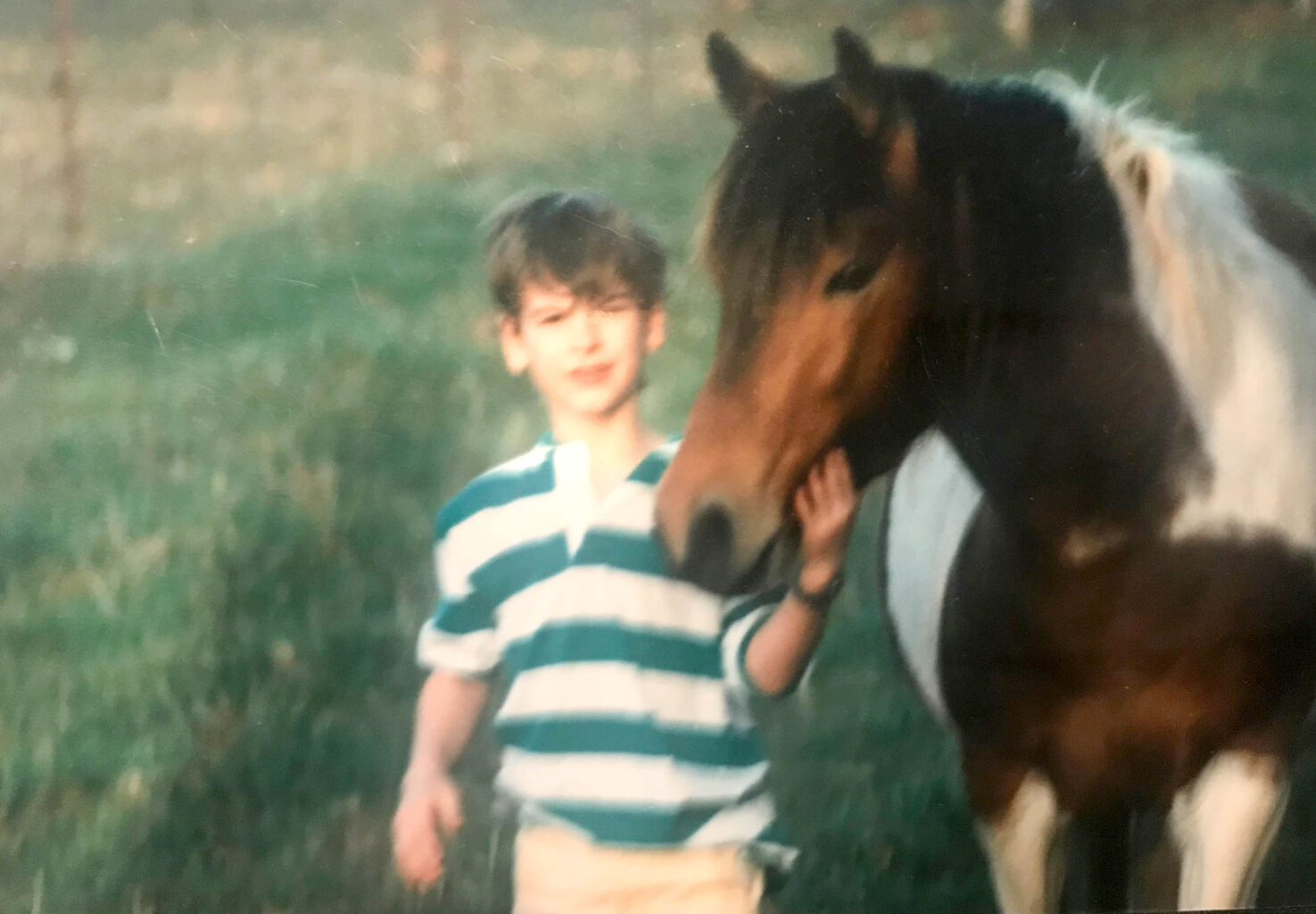
Left: Nathaniel Williams During the Interview, January 2023, Photo by Ph. Tok
Right: Nathaniel Williams at the age of 8 or 9 in Winchester, Tennesse
In the Appalachian Mountain Range
Philipp Tell me something about the landscape you grew up in.
Nathaniel I was born in Alabama. My father was from there and my mother was from Tennessee. My father grew up in the same town as Harper Lee, the author of ‹To Kill a Mockingbird›. Harper Lee was friends with my grandmother and my father was sometimes invited to have tea with her. As one might expect, she loved children. My mother was from Tennessee, just north of Alabama.
Culturally, the southern part of the US inherited the worst legal traditions from England. This class-oriented culture made the justification of slavery very easy, while the northeast originally had a spiritual utopian culture among the colonists. On the other side there are amazing qualities among the people there. Harper Lee is indeed one example, but we also have to recognize that Martin Luther King jr was a southerner, and the rich, long-strided and ethical tapestry of his speech reveals something about where I am from as well.
My parents homeschooled me until I was 10, and I grew up on a farm in Tennessee with 500 acres, cows, horses, dogs and cats. My mother taught us one day a week, and the rest of the time I was outside in the creek or woods with my three siblings, a few friends or my cousins. In a way, I was protected from the racist culture of the South, which I encountered later when I went to school.
I was raised on the western slopes of the Appalachian Mountain Range that runs from Georgia to Maine. The terrain gradually becomes flatter and more hilly as it approaches Memphis, where Elvis Presley’s Graceland is located. It eventually reaches the Mississippi River, a massive waterway, which lies at the heart of the country. The river is fed by streams that run through the Appalachian Mountains in the east and the Rocky Mountains in the west.
Regarding my time in the South, it has been a journey for me to reconcile with the negative stereotypes associated with the region. My experience of the South was deeply connected to the land, climate and animals, which is rich and vital. I do cherish the warmth of the people and the landscape. The light in Tennessee, for example, has a unique quality that permeates the earth, and there is a lot of heart in the people.
When I lived in New York, I moved to a place on the east side of the Hudson River. From there, I could see the beautiful Catskill Mountains, part of the northern Appalachian chain. One of the earliest American painting movements originated there, the Hudson River School, which was deeply inspired by the mountains. The light is so surreal, it is almost like the mountains are apparitions, with a weightless quality. They are both sublime and weightless. Even after fifteen years of living in New York, I still felt that the light had a distinct, otherworldly quality.
Philipp Any important people in those early days?
Nathaniel I have a friend, whom I met when I was around 8 or 9, an interesting fellow. He grew up on a hippie commune called the Farm outside of Nashville, Tennessee. It was founded by Stephen Gaskin and his wife, Ina May Gaskin. Stephen was a famous teacher from the counter cultural movement in the 1960s and Ina May wrote a hugely influential book called ‹Spiritual Midwifery›,* promoting non-hospital birth, informed birth culture, and birth rights. To this day, when I mention living near the Farm, people tell me about being born there because of the famous midwifery center. The Farm was a direct link to the counterculture of San Francisco in the 60s. Stephen Gaskin held his famous, weekly Monday night classes that attracted 1000-1500 hippies, where they discussed everything from spirituality to the Vietnam War. After traveling the country giving talks to young people, Gaskin took a caravan of people to Tennessee and founded the commune, which still exists today.
I was exposed to the qualities of interest and spiritual questions from the 60s, as well as the drug culture, through my friend Simon. My friend is a kind and genuine person who is truly interested in everyone he meets. He has always been very dear to many people. He and I spent a lot of time together and through him I was exposed to a variety of experiences such as playing in a band and traveling the country playing music. We remained close until I came to Europe when I was 19.


Left: Banjo Mountains, a view from the Hamlet of Harlemville, NY, by Nathaniel Williams
Right: Sequatchie Valley View from the Cumberland Plateau, Tennessee, J. Stephen Conn
Europe and back
Philipp What sparked your interest in Europe?
Nathaniel I grew up with classical and romantic German books on the shelves. My mother studied German literature and she was later awarded a Fulbright exchange and took her family with her to the Black Forest in Germany. That’s where I spent ten months at 16, learning the German language and being exposed to the town of St. Georgen. My existential interest in spirituality had been awakened for two years by certain experiences. I was looking for firsthand descriptions of spiritual experience. I read everything I could find on the subject, from Aristotle to Tibetan Buddhism. I eventually found books by Rudolf Steiner. Initially, I was unsure of the authenticity of his own experience because of his intellectual demeanor.
Philipp What brought you to Switzerland when you were 19?
Nathaniel I was playing in a band in Atlanta and reading books by Rudolf Steiner. I read ‹The Philosophy of Freedom› and had a life-changing experience while reading it. I experienced independent thinking, free of my body. I was so impressed by the clear and transparent description in the book and how following it led me to a variety of insights and experiences that seemed revolutionary in their importance. I was only 19 years old and I remember having the distinct thought that the book needed to be distributed to researchers working on the relationship between the body and the mind. I was determined to learn more, so I quit my band, bought a one-way ticket, and came to Switzerland. I asked myself, where is the place where Anthroposophy is being worked with seriously? The Goetheanum seemed a good place to start. I was looking for a philosophical department. They didn’t have anything that specific. I eventually met Zvi Szir, who was starting an art school in Basel. He was working with spiritual experience of thinking while also reading Foucault and Deleuze and exploring contemporary philosophy. But he was teaching painting, not philosophy. Before I knew it, I was in a painting school, which made my father exceptionally happy because his first profession was as a watercolor painter. He was over the moon and sent me a huge box of brushes and all kinds of things. This led to three years of painting and studying Anthroposophy.
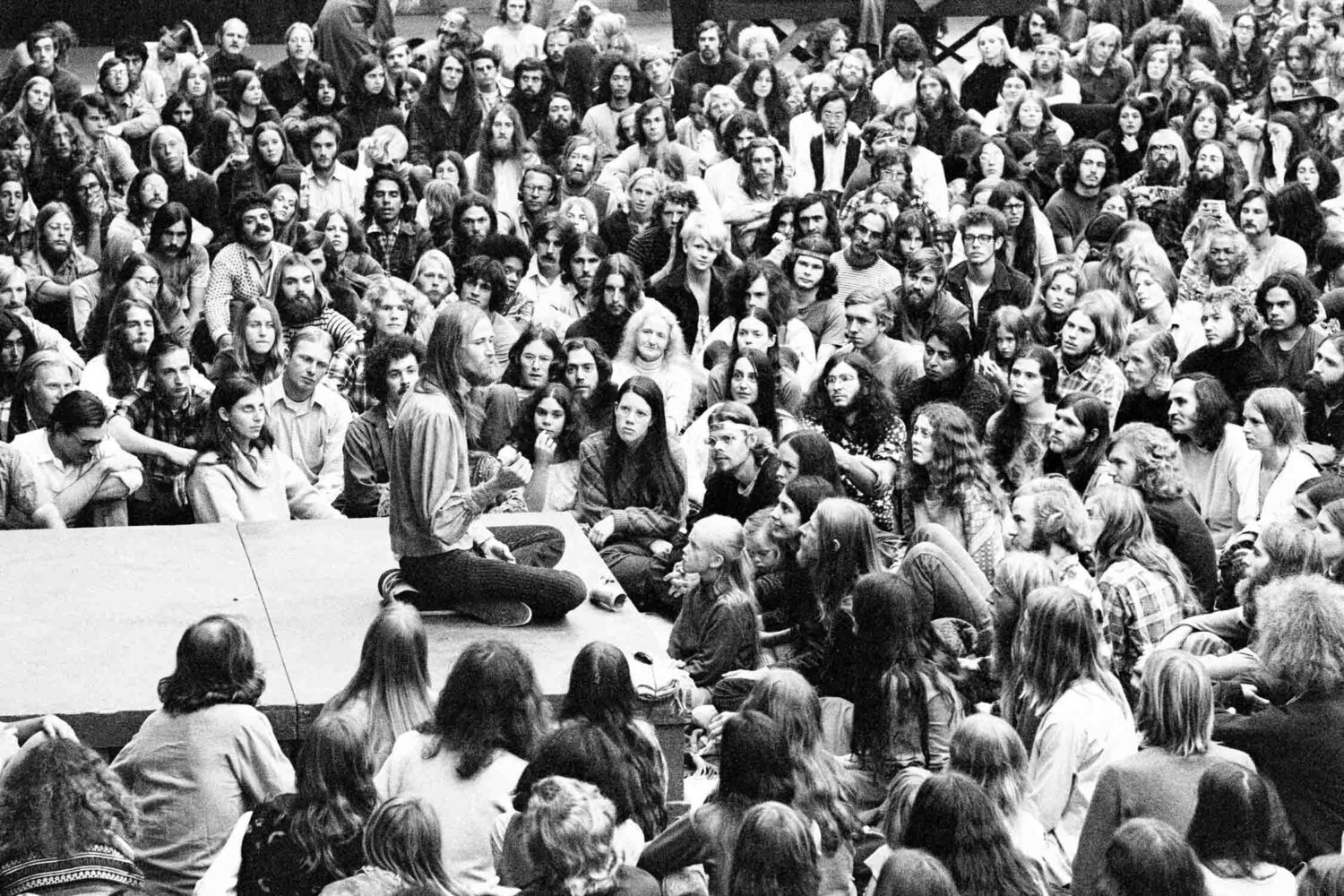
Philipp Did you perform puppetry during that period?
Nathaniel Well, that was a unique experience. I had an exhibition of my final works at the neueKUNSTschule, and I had large oil paintings on display. Thomas G. Meyer, a well-known puppeteer and former director of the Blaue Blume, came to visit the exhibition and ended up buying one of my paintings. We struck up a friendship and decided to collaborate on a project. I created sets for him and even played marionettes for a year. We did a small tour in Switzerland, performing excerpts from Rudolf Steiner’s Mystery Plays. It was a passionate relationship of mutual interests. Puppetry was my venue, but I learned a lot during that time. – Study? – I don’t know if I would call it so. It was better.
Philipp Four years altogether. And that was enough?
Nathaniel That was enough. Something inside me was like, ‹I want to do something more here,› but I couldn’t figure out how. So, I made the decision to move back to the US with my wife at that time, and we went to the USA together. She already had a child from a previous relationship and the three of us moved to the middle of nowhere in Tennessee. We made a living cleaning houses. I spent most of my time painting for two years. I felt more at ease in the US, I could live cheaply and focus on art.
Philipp So, how did you end up in New York?
Nathaniel It’s an interesting story. Let me give you a brief rundown. Moving to the US was tough on my former wife. We lived in a really isolated place in the South, where you had to use a 4-wheel drive on the way to our house. She wanted to pursue a career in early childhood education at that time. [14] We met some people at the Waldorf School in Nashville, Tennessee and I got involved in teaching. I assisted a bit at the school and it was fantastic. I always love teaching at Waldorf schools. I feel truly blessed to have been part of various schools periodically in my life. My wife at that time was further looking for a place where she could find fulfillment in her work. That eventually took us to New York. I didn’t mind where I was, as an artist I felt I could be anywhere.


Left: American Rivers, source: American Rivers
Right: US Mountain Ranges, source: BurningCompass
Philipp Can you tell me about the Free Columbia project?
Nathaniel When I first moved to New York, I didn’t have any job prospects. I went to the Waldorf School, but they didn’t have any positions available. So, I found myself doing independent art projects. I created a marionette production of the play ‹Oedipus› by Sophocles and toured it in the Northeast. An older artist then approached me, asking if I would help her start an art school that incorporated contemplative approaches to visual art inspired by Anthroposophy. That’s how Free Columbia started. We began in her studio and gradually grew.
It was focused on visual art in the beginning. Then we incorporated different disciplines like social theory, political theory, and shoemaking. We even had a relationship with a nearby Goethean research institute, the Nature Institute, which allowed us to incorporate subjects like color theory, biology and evolution into the curriculum.
The project ran for seven years. I took a break from it for a couple of years to study political theory at the University of Albany. The program is ongoing, now under a new director who has shifted the focus more towards practical arts. It’s called the M.C. Richards program.

A perfect Storm
Philipp Can you introduce us to the work you undertook in your Political Theory Ph.D?
Nathaniel Today we have the digital revolution and the ecological crisis happening at the same time – two movements going in opposite directions, creating a perfect storm. The digital revolution has allowed us to move in cultural worlds of light, which are the screens and the symbols and what we call websites, and ways of communicating that are really untethered by the constraints of space and time. Here, we are able to disassociate from our terrestrial experience on the earth, expanding into a very different kind of experience. At the same time, it has become clear that we must strengthen our connection with the earth to avoid intensifying the catastrophic and tragic situations we see around us.
The last 400 years have seen a gradual shift away from a finite, pictorial understanding of the world towards a more abstract approach, specifically in the natural sciences. The particular method that developed grew from the application of mathematical concepts and astronomical observations. It is an interesting paradox that, while one would expect that centuries of focus on nature studies would give us an intimate, contextualized, and rich experience of our planet and the world in whose life we share, this is not the case. Our techno-scientific culture has a characteristically distant, abstract and domineering attitude toward the natural world. We can see this in the techno-utopian efforts of transhumanists as well as in well meaning environmental scientists who conceive of the world as a mathematical matrix of functions.
It is in this context that Goethean Science, as a specific branch of phenomenology, really stands out powerfully as an important cultural treasure. I presented the work of three natural scientists from the last 50 years who developed research in physics and biology in the lineage of Goethe, who are able to develop pictorial, or aesthetic judgment, into experiential understanding of the natural world. We find in them what we expected to find before, that empiricism, when it is truly loyal to experience, does indeed root us deeply and specifically into our terrestrial context.
One of Hannah Arendt’s most insistent points was that a new scientific culture was necessary, from which a love for the world could develop that would be strong enough for us to voluntarily want to take responsibility. This is the crux of the last chapter of her great work ‹The Human Condition›. In a later work, she highlighted the work of Adolf Portmann, one of the most amazing biologists of the last century, as a trailblazer in this direction. This connection to our finite experience on Earth has ecological implications and highlights the importance of the love-responsibility dynamic in politics and policy-making. This ties into politics and policy, as we need to care about the earth enough to take responsibility for it. In my thesis, I frame this as a democratic challenge. If we are not able to develop our culture and our economy so that we can voluntarily give ourselves in a way that is in more harmony with the conditions of the earth, we will increasingly find ourselves in states of emergency. Democracy requires a population that is motivated and willing to work together to address these issues. Otherwise, we risk heading towards a crisis, which can lead through martial law during an emergency situation, to dictatorship. This train of thought ties into a lineage of work exploring the connection between aesthetic judgment and politics, a lineage that was launched by Friedrich Schiller’s ‹Aesthetic Letters›.

I was focusing on an empiricism that is based on developing sense experiences into understanding. One can expand this practice by organizing sense experiences into rich, imaginative images. This is where Anthroposophical contemplative work, called imaginative practice, comes in, which allows for a dynamic and creative world to emerge right on the threshold of full immersion in nature. Through certain contemplative practices one discovers that spiritual, ethical and creative dynamics are surrounding us and that they are integrated into every aspect of existence.
But I think to go there, without addressing the natural scientific and economic dimensions of our crisis, would not be enough. I suggest that what is called for is a widespread pedagogy in aesthetic-empiricism in natural science, which has made important beginnings in Waldorf schools, as well as transforming our marketplaces, places of production and distribution, and the whole economy. I am only able to touch on the economic point toward the latter part of the dissertation. To move in this direction involves getting past advertising and quantitative spreadsheets and getting a concrete understanding of where products come from and the conditions under which they are made. This is one of the main sociological suggestions Rudolf Steiner developed in his lectures on economics. This way, a voluntary and spontaneous impulse of altruism can arise in the pursuit of associative economics. This can lead to less consumption and a willingness to pay more – in short, aligning one’s actions with the material realities of the earthly conditions of our economy.
The fact that the spirit is immediately present and connected to the earth is revolutionary and hugely significant. It’s not just for biodynamic farmers but for everyone, including pharmacists, there are so many directions to go with this. Still, the elephant in the room is the global economy, economic oligarchy and ecological and social devastation. We need to imagine ways not only to talk about it but to feel it in our hearts and our will, to bring a humane influence into the current chaotic economic situation on the planet. I’m just thinking about the next 30 years. There isn’t a serious movement for social threefolding right now, but I’m open to it and ready to play any part I can. I believe there’s a sociological truth connected to the ideas of associative economics that can have a positive impact globally.

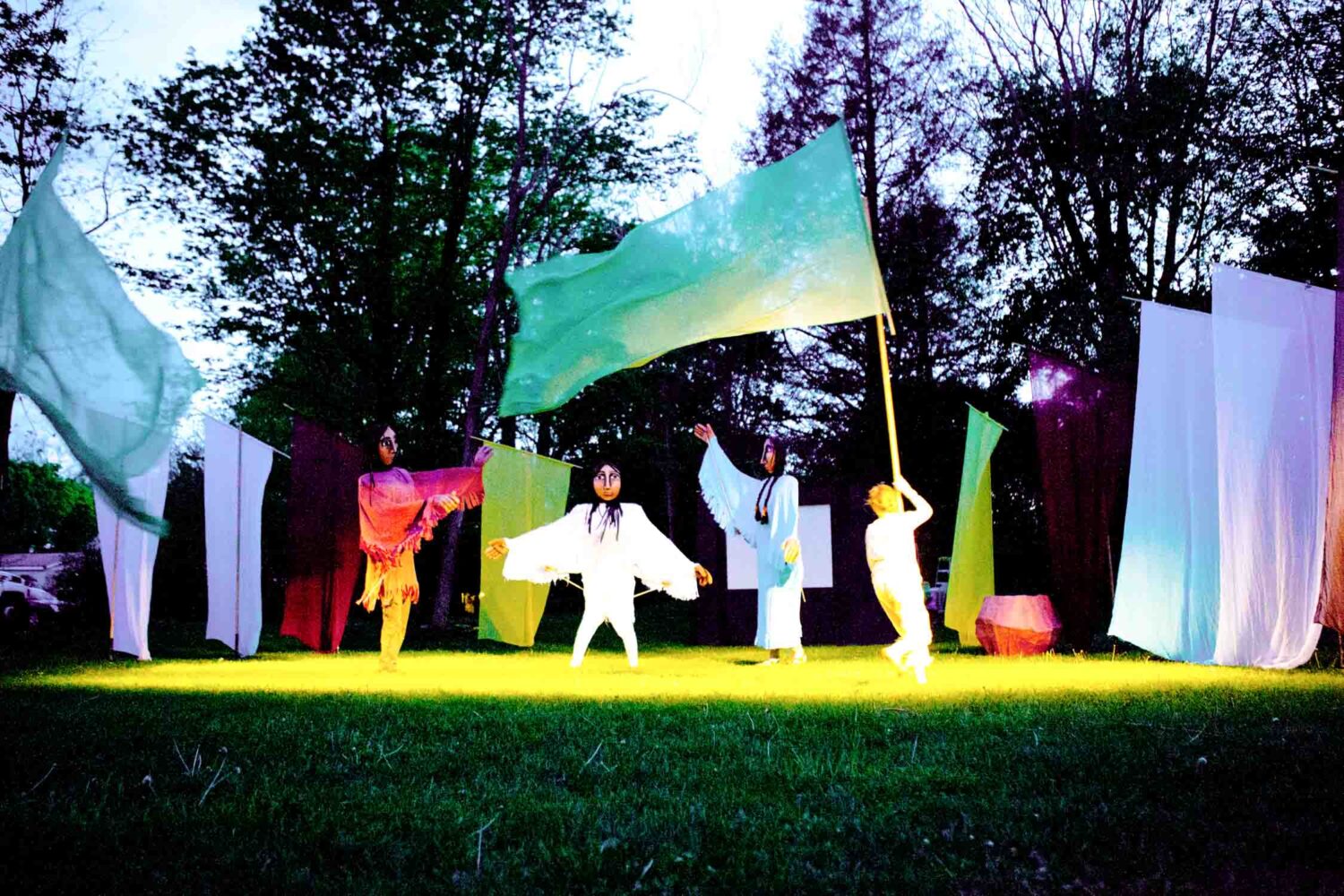
Left: The play ‘Claverack Calico’ with participants in the M. C. Richards programme on the Anti-Rent War (1839-1845) in New York, February 2022. Nathaniel Williams with banjo in the back row on the right.
Right: The Peacemaker, Jigonsaseh and Ayowotah begin to travel, spreading the message of peace. Photo by Fumie Ishii
Icons for the Youth Section
Philipp Who are inspiring public figures that you see as role models for the Youth Section? – I remember that you were deeply inspired by Pete Seeger, the folk musician. He played a big role in the movements of the 1960s.
Nathaniel Yes, Pete Seeger. He is definitely an icon for the Youth Section. 120 years ago, when Anthroposophy was just starting, Rudolf Steiner was experiencing something new in spirituality that had not been possible before. A group of young people in Germany and Europe were also experiencing this. They were called the Wandervögel and were like proto-hippies. They would go out into nature, sing, camp and have deep spiritual experiences. When Steiner founded the Youth Section, he did it for this group of young people, recognizing the new spirituality that was coming into effect. And I see that same spirit in the countercultural movements of the US. Unfortunately, like the anthroposophical movement, it has not reached its full potential. But in Pete Seeger’s voice and his desire to sing with people, not for people, he played a significant role in the counterculture of the 60s and the civil rights movement. There’s this human-affirming power in him, and his banjo is overwhelming. So, Pete Seeger is definitely one.
Phillip I wonder how you will pick up on him?
Nathaniel: My banjo is on the way! It’s on the ship. I love singing songs with people and I feel a connection to the spirit of music. Without a doubt, I think that so many movements in the last hundred years in the US are connected to the concept of authenticity, which has been hijacked by consumerism. Whether it’s Amazon or lifestyle or new age consumerism, it’s all connected to a new experience of the spirit that is being corrupted. People can recognize this change not just in music, but in social science, political theory and even the way people talk about rights. There was a shift away from the likes of contract law to the idea that rights are about the individual’s experience, that life should be an artwork, with freedom of speech and religion being examples. All of these rights were known in the Bill of Rights, but now there’s a growing feeling that human beings are spiritual beings, and that’s what the dignity of rights should rest on. This idea can be traced back to the German and American romantics and the English romantics in the 1700s. So, I believe all of this is connected to the new spirituality and the Youth Section has a particular relationship to it even today.
Mary Caroline Richards is also an inspiration to me. She passed in 1999 after a long and creative life. Her creative spirit expressed itself in poetry, essays, ceramics and visual art. She was a person deeply connected to her time, and following her biography, one can learn so much. After jumping through all the hoops and reaching the top of the academic obstacle course, she discovered it was a sham. She had been duped. She felt the most important things in life she was oblivious to. She got a teaching gig at the famous Black Mountain College and a radical transformation started. Later, she published the book ‹Centering›, which was influential in the 1960s. Her connection to Rudolf Steiner and Karl König’s work became central for her in life and she introduced countless people to Waldorf education, Biodynamics and curative education. In her, a holy fire was raging. She is a person who understood the connection between the counter-cultural movement, the new age movement and Anthroposophy. Our Micro-college program at Free Columbia was named after her, the M.C. Richards Program.

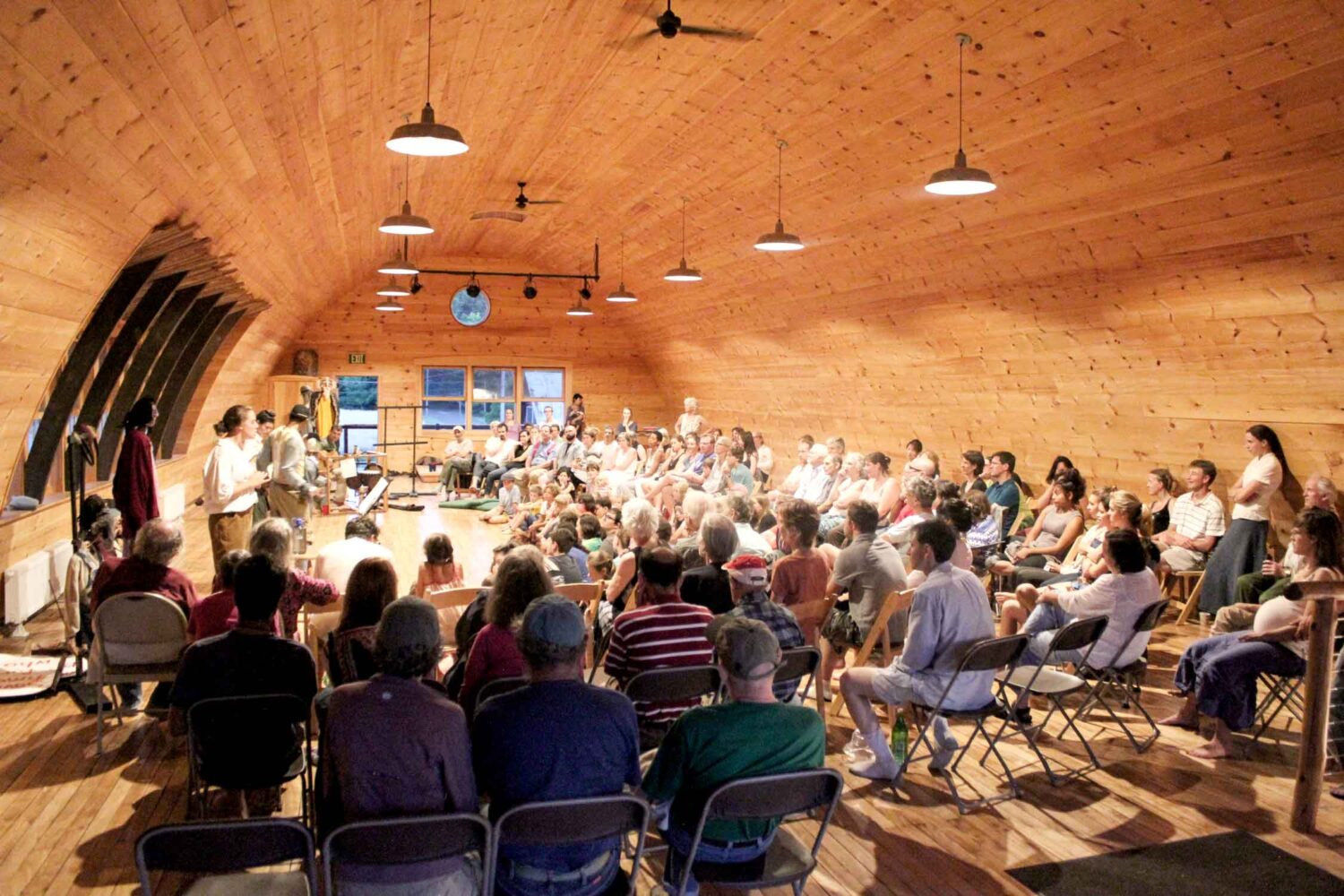
Left: Mary Caroline Richards from her Papers, Getty Research Institute. Creative Commons
Right: M.C.Richards Programm
We’re Just Starting
Philipp What is your approach to anthroposophy?
Nathaniel In the Northern transatlantic civilization, there’s a belief that truth can only be apprehended passively, through observation. This has led to a distrust of philosophy. Despite the religious population in the US, this fundamental tenor remains.
Anthroposophy, for me, is different in that it requires active participation. It’s a movement counter to the passive approach, and one of its core characteristics is that only through creative participation can one enter into spiritual experiences. These experiences are not just limited to one’s inner self or subconscious, but they extend to the spiritual realm of other living things such as plants and animals. This is achieved through imaginative, contemplative practices.
I find this concept important because it highlights the need for a branch of culture that recognizes and values the hallmark of anthroposophical work – that through inner participation and activity, one can grow into an experience of spiritual dimensions beyond the self. This requires a shift in register from the passive to the participatory and also challenging the stark world-self divide that has crystallized out of the last centuries of cultural development. Through participation, one’s consciousness is intensified and one can remain engaged in the experiences even while one is not contained in one’s personality.
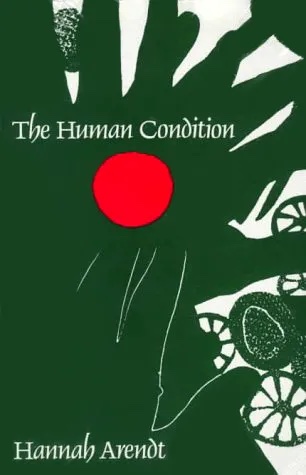
Philipp Can you summarize it in one sentence?
Nathaniel Let me think. I’m not sure I can, but I’ll try. Anthroposophy, for me, is a spiritual practice that allows one to experience the greater world and others through free participation in the Spirit.
Philipp Okay. You first came to the Goetheanum in 1999. What does it mean for you?
Nathaniel The connection to the Goetheanum never faded for me because it’s a spiritual event, not just a physical place. I never doubted my connection to it. I was working intensively with the spiritual aspect of it. It’s a spiritual place with great potential for the future, in terms of culture and promise. In some ways we’re just starting to work with it, and it poses a significant question for the Anthroposophical movement and the world at large. This is because it is such a radical sea-change and it will take generations for it to fulfill. I see this as a dramatic moment in time, and though it’s naturally causing anxiety, I feel that we haven’t fully grasped the momentum of the situation.
Philipp How is that informing your outlook on leadership?
Nathaniel My goal in joining the leadership at the Goetheanum is to contribute as I can, to stay connected to the spiritual aspects, and to try to bring that into everything I do. The drama of the situation is evident, and it’s important to be conscious of it in the Anthroposophical Society. One challenge is to foster more and more connection, clarity and goodwill in relation to the movement and initiatives around the world. I’ve experienced this challenge both at the Goetheanum and in the Society in the United States. It’s a serious issue that we’ll all need to be a part of resolving. If this is not achieved we will find more and more initiatives unable to maintain an authentic connection to the spirit of the movement. On the other side, the Anthroposophical Society is in danger of being unable to maintain its service oriented, loving connection to life and global society.
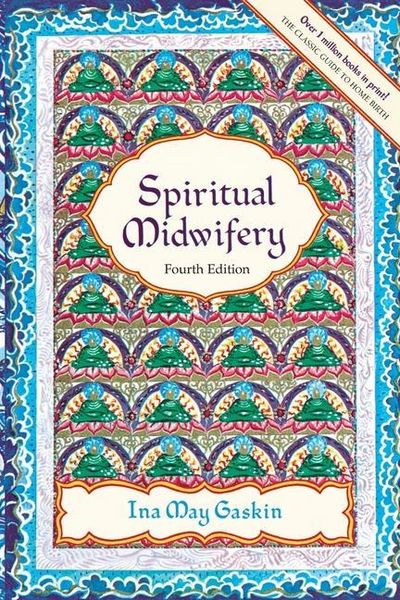
Philipp What do you see as the biggest potential of the Goetheanum and the Anthroposophical Society right now?
Nathaniel Despite some unfortunate aspects of our society’s history, I believe the good times are here, right now, in some important ways, in the very fact that the society exists. When we look back into the trials of the last century, this is not a given! I also feel so much gratitude for all the individuals who have developed Anthroposophical work in various practical fields, the world over, with so much love and sacrifice. I feel support from those who have lived through difficult times in our history towards reconciliation and a clear purpose. Whether or not we can participate in this good will is a question to consider every day. However, I see potential in building on the unity and clarity of purpose that still exists within the society and larger community. We still face cultural issues of fighting, fanaticism, and immaturity, but there is a spirit of human love that can function as a shield and protect the values and the spiritual reality of humanity as well.
I also think that speaking authentically about our experiences with courage is necessary for Anthroposophy to grow. This kind of open and honest conversation, from a place of love, will prevent the society from being seen as just another sect or religion. It is based on an intention to develop contemplative approaches to the spirit that result in insight and understanding, not dogma and faith. If it is approached from a place of love, it will attract people like Pete Seeger, who did in fact visit a Camphill and recognized the specialness of the place before he passed away.
Philipp Let’s take a look at the Youth Section. What do you see from here? How do you view its task and mission?
Nathaniel The Youth Section has a distinct mission of providing opportunities for young people between the ages of 14 and 35.
We all know that one can have the impression that young people are like blades of grass, illuminated by the sun, and their bodies are somehow translucent, allowing one to sense their spiritual presence. This is tremendously significant, more so than having all one’s concepts and questions in life chiseled out. To meet young people here a certain sensitivity for this is important. Young people’s decisions are often based on immediate experiences and clarity of heart and will, rather than having a conceptual understanding of Anthroposophy.
A big task of the Youth Section today is to connect people in the world who are already working with Anthroposophy in this way, so that they can find their reflection and desire to affiliate with our work. It is about creating a collaborative global culture. That’s one of the first things I want to focus on this year, but there are many more specific tasks.
Your Promise
Philipp What do you want to teach? What can people expect of you and what is your promise?
Nathaniel What do I want to be an example of? I think one of the biggest things that I have personally experienced and that is connected to me is that spirituality has been closely tied to crisis in my life since I was young. Because of that, I have a sense of urgency about the importance of the work we’re doing here. Secondly, I have personally experienced the power of reconciliation and redemption in my life on more than one occasion, and I feel that that puts me in a good position to connect with people during the moment we’re in, as I think more and more people will be drawn to the things we’ve been talking about due to the crises and challenges we’re facing. And I also think this will be especially true for young people.
Philipp What type of support do you wish for?
Nathaniel Joy is one of the biggest forms of support we can give each other. To have a common goal that we all feel is the right thing to do as a group or team. That’s a huge support. I want to have a culture where I’m happy to work on something, where I come into a room with other people and feel joy seeing them, knowing that we have a clear heart and will to do something without question.
Philipp Who would you like to knock on your door and who would you like to work with?
Nathaniel One of the things I’ve been paying particular attention to is the young people who come to me and say, «I’m here, and I’m interested in this, and I want to do something with it. And I have faith in an Earth that I walk on, that is an emanation of the being that supports all of us.» This is the right person, and these are the right words they’ve used. And to see what we can develop from there. I do feel an interest, particularly in hearing from young people whose words shake on the surface as if they were big bells, and what resonates within them, in their hearts or in their will, is like an earnestness and clarity of purpose related to the new age that we live in.
I’m also keen to try to find resources to work on some of the transitions that we’ve been talking about, where if young people can find one another in a society of this clarity and this quality, they can take their place here in the coming years, which is a serious question, considering that I believe 4 to 5% of the members of the Anthroposophical Society are under 40 globally.
Philipp Thank you.
Nathaniel Thank you for asking.
Title image Nathaniel Williams. Portrait by Xue Li












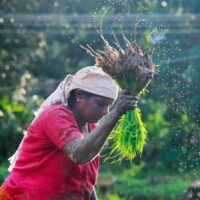

Thank you for this talk.
I am 70, eurythmist in Québec Canada.
I was once a ‘hyppie’ looking for new links with nature, human beings art etc. I met MC Richards at 25 years’s old just when I discovered Anthroposophy in the States, and was very impressed by her and her friend Sabina Nordoff, eurythmist.
I was for a while a puppet artist also… SO yes, I feel a connexion.
But most of all I was involved as eurythmist, for years, with tennagers. I am very conserned with what the youth has to encounter now . To read this article gives me hope. Thank you to be there for them.
Sadly the anthroposophical movement in the USA was stunted by the 1960’s contra culture revolution and the accompanying world’s political/socio/economic situations (Viet Nam) so that anthroposophy in the eastern half of the continent took on a different perspective/objective then the west coast California Oregon Washington etc where revolution against all forms of social order and particularly the entrenched religious prejudices of the eastern/southern states that still suffer from polarization of the civil war. Luckily for the western anthroposophical movement that never felt constrained/restricted and their very open mindedness to alternatives like Theosophy/Anthroposophy and it’s many influential adherents (Krishna Murti Annie Besannt etc) the evolution of Anthroposophical thinking continues to blossom beyond the rather conscripted approach taken by the European post WW2 Goetheanum generation who still practiced a certain belief in the individual (Rudolph Steiner). Perhaps their inability to re-open their perspective to new vision’s/areas of Anthroposophy, instigated a growing spiritual divide between older and newer spiritual pilgrims. The west coast development of Anthroposophy has resulted in an entire generation of NEW Anthropops who’s perspective has reawakened or re-energized the entire movement as can be seen from the tens of thousands of people who’ve attended the now legendary Consciousness Studies seminars at RS College in Fair Oaks CAL and in many other locations on the west coast. As a migrant German with an Anthroposophical baptism, the astounding work of Denis Klocek and so many others, has provided such a rejuvenation in spiritual science and all of the various scientific practice’s that Rudolph Steiner pursued with/from a spiritual as well as scientific perspective that has continued be expanded by so many western anthroposophical adherents. One can only hope that more of the younger generational students from the other half of the US will find a place to study and contribute to the future of the world wide movement of what the Goetheanum represents to humankind!
This is a message for Nathaniel. Nathaniel, I would like to connect with you and send you a book and poetry that I have recently published. I have roots and a chapter in my life from Hawthorne Valley in New York. My email is – moralivingmicrobes@hushmail.com Be blessed, Nicholas.
Wonderful to read Nathaniel, keep you in my thoughts and blessings!
Inspiring article. Nathaniel—met you at Sewanee right before you left for Néw York. I visited that house out Brakefield road. Good luck with your new role. Hope to see you in Dornach someday.
Rob Chenoweth
Néw Orleans